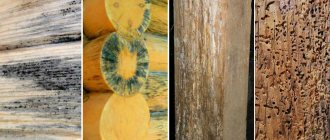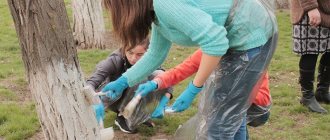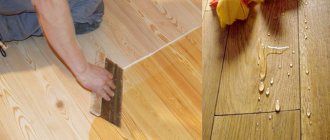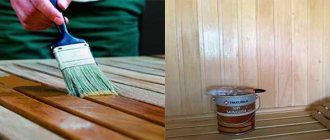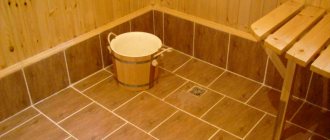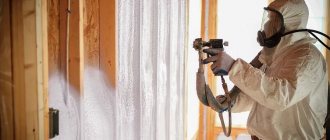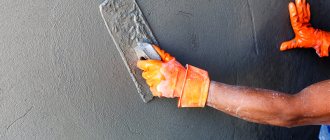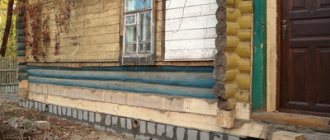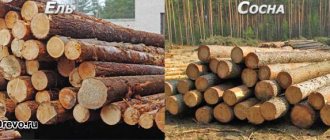Water-repellent impregnation for wood
Hello dear readers and regular blog subscribers! Today we will “protect wood” from moisture...
Wood is without a doubt the most popular and widely used building material. We use it to build bathhouses, houses, make furniture and other various household utensils. Wood attracts with its aesthetics, environmental friendliness, elegance and ease of processing.
Recently, water-repellent impregnation for wood has become an integral attribute of any construction site. And this is truly the right decision. We will try to consider why this happens in this article below...
How does the process of rotting wooden structures start?
Biological decay of wood occurs both in the presence of one of the following reasons, and in a combination of them:
- The material’s own moisture content exceeds 15%
- access of oxygen to wooden parts
- warm and humid climate
- high humidity in the storage area
- multiple freeze/defrost cycle
- sudden changes in temperature
- the appearance and physical qualities of the tree.
These factors create conditions for the development of parasitic fungi, which trigger the process of wood rotting.
If storage conditions are violated, end cuts of fresh logs and entire stacks of lumber may suffer from post and warehouse fungi, which outwardly resemble mold.
Building materials and finished wooden structures are susceptible to damage from house fungi if the installation technology was violated, special protective equipment was not used, or safety precautions were not followed during operation.
The destructive process begins from the outer layers. Gradually, the parasite penetrates and destroys the tree.
Four stages of wood destruction
Elementary. The fungal mycelium progresses only on the outer shell of the tree; the internal structure retains its integrity. The color of the wood becomes grayish-gray.
Development. Uneven pits appear on the wooden part. On the cut, you can find white layers of mycelium among the tree rings.
The final stage. The wood has lost its strength. It either crumbles or splits into small chips.
Mechanical destruction of the wood structure in a separate area. Hollow formation.
DIY tool box according to drawings: instructions with step-by-step guide- Form for paths - a large selection of forms and a simple method for creating a beautiful and comfortable garden (photo + video)
Do-it-yourself snow blower - we remove snow easily, an overview of designs and types for a suburban area
How to prevent rotting: protective compounds and treatment options
The best ways to protect wood from fungus is to prevent the penetration of spores in the early stages of raw material procurement and lumber production. To do this, you need to dry the wood.
The ideal option is industrial drying at a temperature of 1000C, when the material is sterilized and spores are destroyed. However, this will not insure the wood against fungal infection in a commercial warehouse or during use.
Treating the wood with a special protective compound will help prevent rotting. There are water-, alcohol- or oil-based solutions, antiseptics, special gels and pastes.
Paint and varnish coatings are also used for this purpose. Some components protect only the outer layer, while others resist parasites, penetrating into the deeper layers.
Proven Components
A universal water-repellent impregnation is one that can effectively prevent the penetration of fire, protect wood from dust, dirt, and prevent parasites from multiplying inside.
When the market is overcrowded with construction components, it becomes difficult to choose the necessary impregnation, and if you ask in a store, they will recommend something unclear to you. Forums where people will not cheat will help you solve this problem.
As for truly universal impregnations, it is worth highlighting the Belinka type. This impregnation is in demand and has proven itself well.
No less famous is the Aqualazul brand, which is produced similarly to Belinka in a large assortment.
Used as a tinting agent for exterior and interior decoration. A distinctive feature of this impregnation is that it dries quickly and has no odor. This is the merit of the manufacturer, who chose ordinary water as the base.
Bioprotection from adverse weather conditions
The destruction of wooden structures occurs due to sudden temperature changes, capricious climate, and high air humidity. Moisture-resistant impregnations and coatings are used to protect terraces, pergolas, gazebos, and garden furniture.
The weak point of such precautions lies in the inability to eliminate the fungus, only to preserve it for a limited time. If the deep layers have been affected, then the wooden parts will begin to imperceptibly collapse from the inside.
Protective coatings are divided into penetrating and film-forming.
Water-based stain provides a minimal level of protection. It has rather decorative functions.
Alcohol-based stain can resist insects and fungal infections, but for a very short time.
Lacquer stain forms a protective film and sets the color tone. It is unable to destroy fungal spores, so it should be applied to healthy wood treated with a water-based antiseptic.
Oil is an effective protection against moisture. When applying the substance, it is necessary to treat every crack, joint, and roughness. The treatment should be repeated once a year.
Varnishes are protective film-forming materials. They emphasize texture and add shine. Based on texture they are divided into:
- glossy
- semi matte
- matte.
According to the composition of the base:
- aquatic
- alcohol
- acrylic
- alkyd
- alkyd-urea
- oil-resin
- polyurethane
- nitrocellulose
- epoxy.
Treatment is carried out once every 1-5 years, depending on the composition. The varnish provides reliable protection from atmospheric influences, but if the product is applied to a surface contaminated with spores, the service life of the structure will be reduced.
Taring will protect the wood from premature decomposition upon contact with wet soil.
Parts located in the soil are not only exposed to atmospheric precipitation, but are also subject to aggressive reactions with heavy metal salts.
To form a protective film on the surface and ensure high-quality impregnation of subsequent layers, the resin is heated to a high temperature and applied to the product.
The best fire retardant impregnations for wood
If the wood trim is located close to an open fire source, it must be treated with fire retardant impregnation. It makes wood a material that is difficult to combust, expanding its scope of application. Here are the best fire resistant formulations.
NEOMID 450
Rating: 4.9
A highly effective means for fire protection of wooden structures is NEOMID 450 impregnation. The composition can be used both inside and outside buildings. When the drug interacts with wood, a poorly flammable and difficult to burn material is formed. At the same time, the wooden surface is protected from rotting and mold. The domestic manufacturer promises up to 7 years of fire protection and 10 years of protection against biological damage. The product is offered to the consumer in colorless and tinted versions. Experts gave the composition first place in our ranking.
Users like the simultaneous protection of wood from biodamage and fire and the ease of use. The disadvantages include the long drying time (12-14 days) before applying paints and varnishes.
Advantages
- comprehensive tree protection;
- versatility of use;
- long service life of the coating;
- different application methods.
Flaws
- takes a long time to dry.
Senezh Ognebio Prof
Rating: 4.8
Comprehensive protection for wood can be created using Senezh Ognebio Prof. impregnation. After treatment, the base becomes difficult to combust, it is not subject to rotting, biodestruction, or the infestation of bugs. Wood becomes resistant to moisture and temperature changes. It is not recommended for treated elements to come into contact with the ground. Users should be aware that after drying the surface changes color, although the natural structure of the wood is preserved. The drug can also be used for biological damage to wood.
Having weighed all the pros and cons of the composition, experts gave it second place in the ranking. Users note the absence of odor, fire safety and ease of use. Among the disadvantages, the high consumption of antiseptic is often mentioned.
Advantages
- comprehensive tree protection;
- treats substrates contaminated with microorganisms;
- affordable price.
Flaws
- contact with the soil is not allowed;
- high consumption.
Making protective compounds for wood at home
Factory-produced antiseptic mixtures are effective, but do not always have an organic base. This makes them more dangerous and requires strict adherence to technical instructions. Protection with homemade impregnations is no less reliable, but safer.
How to make a high-quality wood preservative with your own hands? The simplest recipe is to use bitumen and diesel fuel.
Fuel (regular gasoline can also be used) serves as a solvent. It is added as the bitumen resin melts. It prevents premature hardening of the composition and helps the resin components penetrate into the layers of wood.
Ideal protection for products that hold the soil and are in contact with the ground: support beams for the gazebo, ceiling beams in the cellar, heels of garden furniture, the bottom and inside of wooden flowerpots and plant pots.
An aqueous solution of copper sulfate is an antiseptic, the base substance of which is metal salts.
Depending on the purpose of use, add from 50 to 400 g of vitriol to a container of 10 liters of water. The solution disinfects the surface from fungus and prevents its reappearance.
For interior work and protecting wooden surfaces from moisture, you can make an impregnation with natural wax based on linseed or mineral oil.
Oil and grated wax are taken in a 1:1 ratio, mixed and heated in a water bath. The surface should be treated with a warm compound. This mixture is also suitable for wooden utensils that come into contact with food.
Preventing the appearance of fungus and rot is much easier and cheaper than dealing with their consequences. To make the right choice of impregnation, you should study the manufacturers, compositions, tasks and photos of wood protection. The durability of wood structures depends on compliance with installation technologies and processing of parts.
Rating of the best wood impregnations
| Nomination | place | Name of product | rating |
| The best wood impregnation for interior work | 1 | Pinotex Interior | 4.9 |
| 2 | Tikkurila Supi | 4.8 | |
| 3 | Aquatex Rogneda Extra | 4.8 | |
| 4 | NEOMID 430 ECO | 4.7 | |
| 5 | Tex Biotex Classic Universal | 4.7 | |
| 6 | Extra Aquatex with wax | 4.6 | |
| 7 | Ecohouse | 4.5 | |
| The best wood impregnation for outdoor use | 1 | Tikkurila Eko Wood | 4.9 |
| 2 | Luxens | 4.8 | |
| 3 | Pinotex Ultra | 4.8 | |
| 4 | EXTREME CLIMATE | 4.7 | |
| 5 | Dufa Wood Protect | 4.7 | |
| 6 | Nortex-Disinfector | 4.6 | |
| The best fire retardant impregnations for wood | 1 | NEOMID 450 | 4.9 |
| 2 | Senezh Ognebio Prof | 4.8 |

